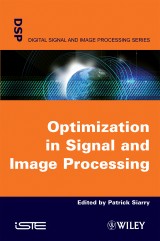Details

Optimisation in Signal and Image Processing
1. Aufl.
|
CHF 150.00 |
|
| Verlag: | Wiley |
| Format: | EPUB |
| Veröffentl.: | 01.03.2013 |
| ISBN/EAN: | 9781118623671 |
| Sprache: | englisch |
| Anzahl Seiten: | 352 |
DRM-geschütztes eBook, Sie benötigen z.B. Adobe Digital Editions und eine Adobe ID zum Lesen.
Beschreibungen
This book describes the optimization methods most commonly encountered in signal and image processing: artificial evolution and Parisian approach; wavelets and fractals; information criteria; training and quadratic programming; Bayesian formalism; probabilistic modeling; Markovian approach; hidden Markov models; and metaheuristics (genetic algorithms, ant colony algorithms, cross-entropy, particle swarm optimization, estimation of distribution algorithms, and artificial immune systems).
Introduction xiii <p><b>Chapter 1. Modeling and Optimization in Image Analysis 1</b><br /> <i>Jean Louchet</i></p> <p>1.1. Modeling at the source of image analysis and synthesis 1</p> <p>1.2. From image synthesis to analysis 2</p> <p>1.3. Scene geometric modeling and image synthesis 3</p> <p>1.4. Direct model inversion and the Hough transform 4</p> <p>1.5. Optimization and physical modeling 9</p> <p>1.6. Conclusion 12</p> <p>1.7. Acknowledgements 13</p> <p>1.8. Bibliography 13</p> <p><b>Chapter 2. Artificial Evolution and the Parisian Approach. Applications in the Processing of Signals and Images 15</b><br /> <i>Pierre Collet and Jean Louchet</i></p> <p>2.1. Introduction 15</p> <p>2.2. The Parisian approach for evolutionary algorithms 15</p> <p>2.3. Applying the Parisian approach to inverse IFS problems 17</p> <p>2.4. Results obtained on the inverse problems of IFS 20</p> <p>2.5. Conclusion on the usage of the Parisian approach for inverse IFS problems 22</p> <p>2.6. Collective representation: the Parisian approach and the Fly algorithm 23</p> <p>2.7. Conclusion 40</p> <p>2.8. Acknowledgements 41</p> <p>2.9.Bibliography 41</p> <p><b>Chapter 3. Wavelets and Fractals for Signal and Image Analysis 45</b><br /> <i>Abdeldjalil Ouahabi and Djedjiga Ait Aouit</i></p> <p>3.1. Introduction 45</p> <p>3.2. Some general points on fractals 46</p> <p>3.3. Multifractal analysis of signals 54</p> <p>3.4. Distribution of singularities based on wavelets 60</p> <p>3.5. Experiments 70</p> <p>3.6. Conclusion 76</p> <p>3.7. Bibliography 76</p> <p><b>Chapter 4. Information Criteria: Examples of Applications in Signal and Image Processing 79</b><br /> <i>Christian Oliver and Olivier Alata</i></p> <p>4.1. Introduction and context 79</p> <p>4.2. Overview of the different criteria 81</p> <p>4.3. The case of auto-regressive (AR) models 83</p> <p>4.4. Applying the process to unsupervised clustering 95</p> <p>4.5. Law approximation with the help of histograms 98</p> <p>4.6. Other applications 103</p> <p>4.7. Conclusion 106</p> <p>4.8. Appendix 106</p> <p>4.9. Bibliography 107</p> <p><b>Chapter 5. Quadratic Programming and Machine Learning – Large Scale Problems and Sparsity 111</b><br /> <i>Gaëlle Looslil, Stéphane Canu</i></p> <p>5.1. Introduction 111</p> <p>5.2. Learning processes and optimization 112</p> <p>5.3. From learning methods to quadratic programming 117</p> <p>5.4. Methods and resolution 119</p> <p>5.5. Experiments 128</p> <p>5.6. Conclusion 132</p> <p>5.7. Bibliography 133</p> <p><b>Chapter 6. Probabilistic Modeling of Policies and Application to Optimal Sensor Management 137</b><br /> <i>Frédéric Dambreville, Francis Celeste and Cécile Simonin</i></p> <p>6.1. Continuum, a path toward oblivion 137</p> <p>6.2. The cross-entropy (CE) method 138</p> <p>6.3. Examples of implementation of CE for surveillance 146</p> <p>6.4. Example of implementation of CE for exploration 153</p> <p>6.5. Optimal control under partial observation 158</p> <p>6.6. Conclusion 166</p> <p>6.7. Bibliography 166</p> <p><b>Chapter 7. Optimizing Emissions for Tracking and Pursuit of Mobile Targets 169</b><br /> <i>Jean-Pierre Le Cadre</i></p> <p>7.1. Introduction 169</p> <p>7.2. Elementary modeling of the problem (deterministic case) 170</p> <p>7.3. Application to the optimization of emissions (deterministic case) 175</p> <p>7.4. The case of a target with a Markov trajectory 181</p> <p>7.5. Conclusion 189</p> <p>7.6. Appendix: monotonous functional matrices 189</p> <p>7.7. Bibliography 192</p> <p><b>Chapter 8. Bayesian Inference and Markov Models 195</b><br /> <i>Christophe Collet</i></p> <p>8.1. Introduction and application framework 195</p> <p>8.2. Detection, segmentation and classification 196</p> <p>8.3. General modeling 199</p> <p>8.4. Segmentation using the causal-in-scale Markov model 201</p> <p>8.5. Segmentation into three classes 203</p> <p>8.6. The classification of objects 206</p> <p>8.7. The classification of seabeds 212</p> <p>8.8. Conclusion and perspectives 214</p> <p>8.9. Bibliography 215</p> <p><b>Chapter 9. The Use of Hidden Markov Models for Image Recognition: Learning with Artificial Ants, Genetic Algorithms and Particle Swarm Optimization 219</b><br /> <i>Sébastien Aupetit, Nicolas Monmarchè and Mohamed Slimane</i></p> <p>9.1. Introduction 219</p> <p>9.2. Hidden Markov models (HMMs) 220</p> <p>9.3. Using metaheuristics to learn HMMs 223</p> <p>9.4. Description, parameter setting and evaluation of the six approaches that are used to train HMMs 226</p> <p>9.5. Conclusion 240</p> <p>9.6. Bibliography 240</p> <p><b>Chapter 10. Biological Metaheuristics for Road Sign Detection 245</b><br /> <i>Guillaume Dutilleux and Pierre Charbonnier</i></p> <p>10.1. Introduction 245</p> <p>10.2. Relationship to existing works 246</p> <p>10.3. Template and deformations 248</p> <p>10.4. Estimation problem 248</p> <p>10.5. Three biological metaheuristics 252</p> <p>10.6. Experimental results 259</p> <p>10.7. Conclusion 265</p> <p>10.8. Bibliography 266</p> <p><b>Chapter 11. Metaheuristics for Continuous Variables. The Registration of Retinal Angiogram Images 269</b><br /> <i>Johann Drèo, Jean-Claude Nunes and Patrick Siarry</i></p> <p>11.1. Introduction 269</p> <p>11.2. Metaheuristics for difficult optimization problems 270</p> <p>11.3. Image registration of retinal angiograms 275</p> <p>11.4. Optimizing the image registration process 279</p> <p>11.5. Results 288</p> <p>11.6. Analysis of the results 295</p> <p>11.7. Conclusion 296</p> <p>11.8. Acknowledgements 296</p> <p>11.9. Bibliography 296</p> <p><b>Chapter 12. Joint Estimation of the Dynamics and Shape of Physiological Signals through Genetic Algorithms 301</b><br /> <i>Amine Naït-Ali and Patrick Siarry</i></p> <p>12.1. Introduction 301</p> <p>12.2. Brainstem Auditory Evoked Potentials (BAEPs) 302</p> <p>12.3. Processing BAEPs 303</p> <p>12.4. Genetic algorithms 305</p> <p>12.5. BAEP dynamics 307</p> <p>12.6. The non-stationarity of the shape of the BAEPs 324</p> <p>12.7. Conclusion 327</p> <p>12.8. Bibliography 327</p> <p><b>Chapter 13. Using Interactive Evolutionary Algorithms to Help Fit Cochlear Implants 329</b><br /> <i>Pierre Collet, Pierrick Legrand, Claire Bourgeois-République, Vincent Péan and Bruno Frachet</i></p> <p>13.1. Introduction 329</p> <p>13.2. Choosing an optimization algorithm 333</p> <p>13.3. Adapting an evolutionary algorithm to the interactive fitting of cochlear implants 335</p> <p>13.4. Evaluation 338</p> <p>13.5. Experiments 339</p> <p>13.6. Medical issues which were raised during the experiments 350</p> <p>13.7. Algorithmic conclusions for patient A 352</p> <p>13.8. Conclusion 354</p> <p>13.9. Bibliography 354</p> <p>List of Authors 357</p> <p>Index 359</p>
<p><b>Patrick Siarry</b> is a Professor of Automatics and Informatics at the University of Paris-Est Créteil, where he leads the Image and Signal Processing team in the Laboratoire Images, Signaux et Systèmes Intelligents - LiSSi.</p>


















